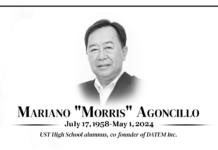UST OFFICIALS have brought a dispute over tenureship to the Court of Appeals, insisting that newly hired faculty members cannot become regulars without earning their master’s degrees within a period of five semesters.
Last October, the National Labor Relations Commission (NLRC) sided with three instructors of the College of Fine Arts and Design (CFAD) dismissed in 2010 after refusing to sign a waiver renouncing their right to tenureship for failing to earn master’s degrees. A motion for reconsideration filed by UST was junked by the NLRC last Jan. 22.
“We are filing an urgent petition with the Court of Appeals to set aside and reverse the patently erroneous resolution of the NLRC,” said Civil Law Dean Nilo Divina, who is also legal counsel of UST, in an e-mail to the Varsitarian.
The dispute centers on a provision in the collective bargaining agreement between UST and the UST Faculty Union (USTFU), which supposedly grants tenure to faculty members after five semesters of teaching. But UST claims this has been trumped by Commission on Higher Education (CHEd) Memorandum Order 40, series of 2008 (CMO 40), or the Manual of Regulation for Private Education of 2008 (Morphe), which states that a faculty member can only be tenured in a higher education institution when he or she is “a holder of master’s degree,” and, if applicable, a holder of the appropriate professional license.
The NLRC ruling is an invalid exercise of police power and a violation of the academic freedom of the University, Divina said. “It also undermines the continuing efforts of the University to improve its academic standards,” he added.
The three dismissed CFAD instructors—Raymond Son, Raymund Antiola and Wilfredo Pollarco—sued UST officials for “unfair labor practices” and illegal dismissal in July 2010.
Divina said the latest NLRC ruling misread CMO 40. “It is crystal clear that possession of master’s degree is a condition for continuation of employment,” he said. “Simple logic dictates that if the faculty member does not obtain a master’s degree within a reasonable period, the same shall constitute a valid ground for termination of employment.”
The University’s motion for reconsideration filed before the NLRC last Nov. 18 said the commission “gravely erred” in refusing to recognize that the CBA provision on tenure had been superseded by CMO 40, and in ruling that the CHEd memorandum was “merely directory and not mandatory.”
Reynaldo Reyes, USTFU vice president for grievance and complaints, said the NLRC ruling was a relief to faculty members who have been victims of unfair labor practice or illegal dismissal.
He also reiterated that the waiver issued by the University was a violation of both CMO 40 and the CBA. “With the waiver, [the University] allows you to continue teaching even though you have no master’s degree so it is against the CHEd memo, because the CHEd said you can’t teach without master’s degree,” Reyes said. “[Teaching] without master’s degree but not [getting] tenured is against the CBA.”
Divina pointed out that UST had given the concerned faculty members reasonable time to obtain their master’s degrees. “In other words, during that interim period, the University will not enforce strict compliance with such directive. The decision not to immediately and strictly enforce the master’s degree [requirement] during that period should not be construed against the University,” he said. “It should not be taken as a waiver of the right of the University to enforce the requirement.”
But USTFU Internal Vice President Rene Tadle said the CHEd memorandum did not state that a school has to terminate faculty members who do not have master’s degrees. “What I think the memorandum states is that UST should help them to acquire those master’s degrees,” Tadle said.
“[UST] should not blame the union as well as the faculty members … there is an agreement [between] both parties, UST and the union, and so we are just being consistent with that,” he said.














